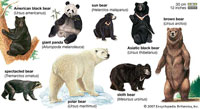 |
| There are eight species of bear and six are vulnerable or endangered. All
are at risk of extinction in some countries. |
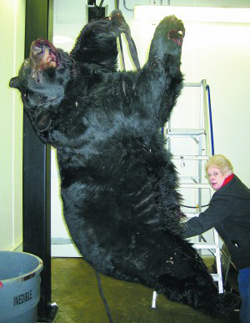 |
| Bear is rarely hunted for meat or
fur but rather for "sport" or trophy
value. |
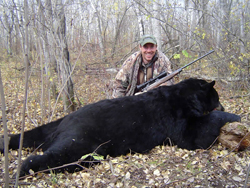 |
| A hunter may prefer to use a
large bullet that will break the
bear's shoulder and continue
through the vital organs,
leaving an exit wound large
enough to leave a blood trail to
assist locating the downed
animal. The expression
"loaded for bear" is no
exaggeration. |
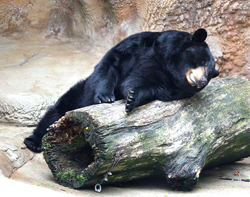 |
| Many animals
suffer
prolonged,
painful
deaths when
they are
injured by
hunters.
Many
hunters
often spend
hours tracking
the
blood trails
of animals
before finding
them.
Many are
never found
by hunters. |
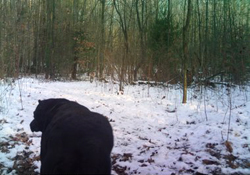 |
Aware and living in a state of fear,
bears, in areas where they are
hunted frequently, move only at
night. |
|
Asian markets place a high value
on the medicinal properties of bear
gallbladder and the taste of bear
paw. Since many Asian bear
species are imperiled, the market
now depends on Russian,
Canadian, and American bears.
The high price paid for
gallbladders and bear paws
provides incentive for hunters to
kill bears. Cubs are worth as much
as adult bears. Many bears are
poached as a result.
|
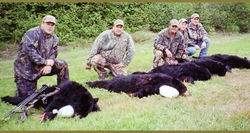 |
| Hunters tend to favor
calibers large enough to
inflict as much tissue
and bone damage as
possible, since bears
can withstand a number
or direct shots to the
limbs or torso. To successfully
kill a bear, one
may have to shoot it
several times, so as to
leave wounds that will
cause the bear to hemorrhage
to death
quickly. |
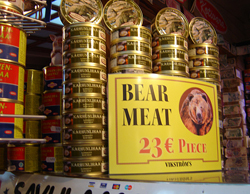 |
| The best meat apparently comes
from young bears which eat more
berries than fish. |
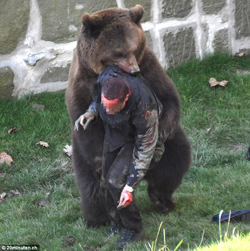 |
| People have been killed while
unloading their guns into a bear
which keeps coming at them. |
| Even when overpopulation occurs, is with a camera.
and starvation and disease occur,
these are nature's ways of ensuring
that healthy, strong animals survive
and maintain the strength level of
the group. |
|
Black bears can be legally hunted
in 27 U.S. states. Many of these
states allow spring hunts, baiting,
hounding, and the selling and trade
of bear parts.
It is estimated that between 40,000
to 50,000 bears are legally hunted
in the U.S. each year. Many more
are poached.
|
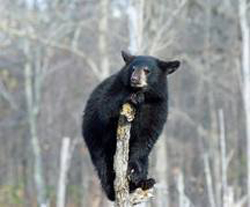 |
| Hounding involves using dogs to
chase and tree bears to provide
hunters with easy targets.
Hounding often separates mothers
from their cubs, leaving the young
orphaned or caught and devoured
by the dogs. |
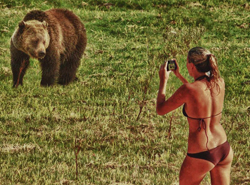 |
| Some say the best way to shoot a
bear is with a camera. |
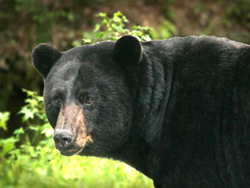 |
| The balance of ecosystems ensures
survival. Natural predators help
maintain this balance by killing the
sickest and weakest individuals.
Hunters, however, kill any animal
including large, healthy animals
who are needed to keep the
population strong. Elephant
poaching is believed to have
increased the number of tuskless
animals in Africa, and in Canada,
hunting has caused bighorn sheep's
horn size to fall by 25 percent in the
last 40 years. |
The state Department of Environmental Conservation (DEC) announced that New York hunters killed 1,337 black bears during the 2012 hunting seasons, making last year the third highest bear "harvest" on record in New York.
According to DEC Commissioner Joe Martens, only the 2003 harvest, with 1,864 bears taken, and 2009 harvest with 1,487 surpassed last year's take.
"New York has excellent bear habitat and vast, accessible public lands that offer exciting opportunities for bear hunting," said Martens. "Black bears are thriving in New York, and they represent a great resource for all New Yorkers."
Hunters found greatest success during the early season, because, after a summer of low natural food availability, with a general lack of soft and hard mast like apples, acorns and beechnuts, bears were moving in search of food and were closer to human food sources.
Hungry bears found feeding in cornfields were easy targets for hunters.
Since 2005, DEC has expanded the area open to bear hunting in Southeastern and Central-Western New York and increased season length, more closely aligning bear seasons with deer seasons, affording hunters out for deer to kill a bear.
These actions were implemented to reduce bear population growth and range expansion and increase hunting fees for the state.
|










